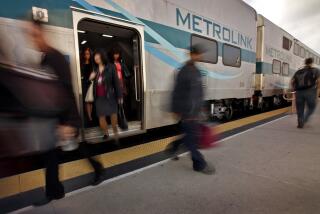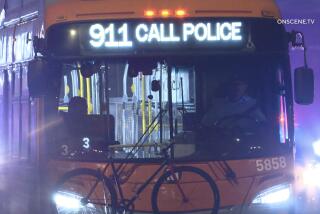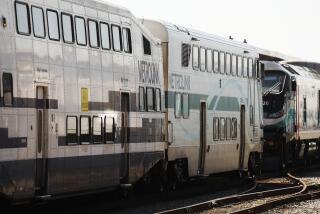Chain-Reaction Crash Kills 11
- Share via
A man apparently intending to commit suicide parked his SUV in the path of a Metrolink commuter train Wednesday morning, then jumped out of the way in time to watch a chain-reaction wreck that killed at least 11 people and injured about 180.
The crash, which involved three trains, was the deadliest on a railroad in the United States since 1999. It shattered the predawn stillness near Griffith Park with what witnesses described as the sound of scraping gravel followed by a sustained boom that shook the ground.
“Before I knew it, there was a big, big bang. I looked out the window and saw fire,” said Teresa Alderete, 50, of Reseda, a commuter whose train car was transformed in an instant from a rolling island of morning serenity into a nightmare of flying bodies, torn metal and shattered glass.
“I was one of the fortunate ones to walk out.”
Officials said the carnage was caused by a despondent man from Compton, Juan Manuel Alvarez, 25, who parked his green Jeep Grand Cherokee on the tracks that run along the border of Glendale and the Los Angeles neighborhood of Atwater Village. As Metrolink’s regular commuter train No. 100 from Moorpark to Union Station bore down on him just after 6 a.m., Alvarez leaped from the vehicle, Glendale Police Chief Randy Adams said. He was arrested at the scene and, after being taken to County-USC Medical Center, was booked on suspicion of murder. Prosecutors are weighing formal charges.
The lead passenger car of a three-car southbound train, which was being pushed from the rear by its locomotive, hit the truck, dragged it down the tracks, then derailed.
As the Metrolink train veered off the tracks, it crashed into an idle Union Pacific freight train that was on an adjacent siding. The impact caused the passenger train to jackknife. Its protruding end smashed into a three-car northbound Metrolink train as it passed on its way from Union Station to Burbank.
The rear two cars of the northbound No. 901 train -- which was being pulled by its locomotive -- also derailed.
“It was almost like a perfect storm of an accident,” said Mary Travis, who oversees rail programs, including Metrolink, for the Ventura County Transportation Commission. “The timing of those three trains being at the same spot at the same time is just too horrible.”
The crash renewed long-standing questions about rail safety in Southern California, where commuter lines share tracks with busy freight systems and intersect frequently with parts of the nation’s most extensive urban road network.
Passengers aboard the Metrolink trains described how the roar of the crash gave way to isolated moans; the chaos of flying bodies and briefcases was followed by a stunned determination to survive. There was little panic, and those who were able helped those who were not.
“Most of the people in my car were fairly calm,” said David McAfee, 50, an architect who works in downtown Los Angeles. “We gathered our thoughts and someone shouted to get us off the train.”
At a makeshift triage center established in an adjacent Costco parking lot and, later, at a community room at the Glendale Police Department, anxious relatives waited for news of the missing.
Throughout the day, the families huddled around tables, speaking quietly with counselors and watching endless reports of the crash on a big-screen television. Periodically, police would enter to deliver the news that another body had been found.
There was no precise count by Wednesday night of the number of passengers aboard the two passenger trains, but Metrolink spokesman Francisco Oaxaca said the southbound train from Moorpark typically carried 200 to 250 people, and the northbound train carried about 30 to 50.
More than 120 people were taken to 14 hospitals, officials said. An undetermined number of others were treated at the scene or sought medical help on their own. As of Wednesday night, at least four people remained missing as rescue crews continued to search the wreckage, some of which burned after the crash.
Trains can attain up to 79 mph in the stretch where the wreck occurred. Officials said, however, they were probably traveling more slowly because the northbound train had just left the Glendale station and the other was approaching it.
Torn and twisted wreckage, yards from the Costco store on Los Feliz Boulevard, showed the force of the collision. The southbound Metrolink train had split into a mangled V, its passenger compartments ripped open in a tangle of roughly sheared metal.
The yellow Union Pacific freight train was knocked on its side, a toppled switching tower dangling above it.
About 20 yards from the train cars lay a wheel and axle, believed to be from the sport utility vehicle that caused the wreck.
Emergency exit panels, seat covers and bloody paper towels were strewn next to the rail cars, as were a jacket and backpack left behind by fleeing passengers.
Within minutes, rescuers -- initially, Costco workers, then firefighters and police from Glendale, Los Angeles and elsewhere -- were helping pull the dazed, the injured and the dead from the wreckage.
In one car, firefighters said, they found an injured man who had written a message in blood on a piece of metal under his seat. It read: “I (heart) my kids. (heart) Leslie.”
The man, whom officials did not identify, was rescued and taken to a hospital.
Officials identified several of the dead: Scott McKeown, 42, who was in charge of the city of Pasadena’s phone, radio and sound systems; Julia Bennett, a 44-year-old senior clerk-typist with the Los Angeles Fire Department; Manuel D. Alcala, 51, of West Hills, a senior general maintenance worker at the County Jail; and Elizabeth Hill, 65, who worked in the city of Glendale financial office.
Also among the dead was Los Angeles County Sheriff’s Deputy James Tutino, a 47-year-old father of four who was on his way to work downtown at the Men’s Central Jail.
“My empathy is with everyone on that train,” Sheriff Lee Baca said. “When you lift up the body of a colleague who seconds earlier had been safe and secure on that train, and place it on a stretcher, and drape an American flag over him, and look down and you find blood on his hands, the blood that sustained his life only hours earlier, and then after that, you find out that some individual who was not happy with his life caused all this death and destruction.... This is a thing to be extremely angry about.”
Alvarez stabbed himself in the chest with a knife and tried to slit his wrists, police officials said, although it was not clear if that was before or after he parked on the tracks.
He apparently turned onto the tracks just south of a crossing at Chevy Chase Drive. Police said there were indications that he tried to back out but got stuck before abandoning the vehicle.
Adams, the Glendale chief, said Alvarez “will be charged with as many lives as were lost in this tragedy.” He described Alvarez as “distraught and remorseful, but cooperative,” and said he admitted leaving the vehicle on the tracks.
Adams added that Alvarez would be kept under close supervision in jail.
Los Angeles County Dist. Atty. Steve Cooley said that it was too early to discuss what charges may be brought against Alvarez, but that he could face multiple counts of murder. Under state law, intentional train wrecking could be the basis for a murder charge that would carry a potential death penalty, Loyola University law professor Laurie Levenson said.
Alvarez also could face separate charges under a law that makes derailing a train a federal crime. If the derailment results in fatal injuries, that law also provides for execution or life in prison without parole.
Wednesday’s crash was the third fatal Metrolink crash in less than three years, and it brought fresh urgency to calls for costly projects that would put rails below or above roadways.
It also raised questions about Metrolink’s practice -- a common one among commuter railroads -- of using a “push-pull” system in which locomotives are in the front of the train in one direction and in the rear the other.
In this crash, that meant a passenger car bore the brunt of the initial impact, but Metrolink spokeswoman Denise Tyrrell said the configuration is not inherently unsafe.
The southbound train that was the first to derail was operating on a route and at a time that were the first in the Metrolink system when it was established in 1992, according to Travis, the Ventura County official. Many of those on the train had been regular commuters for a decade or more, and had developed daily routines and friendships.
Russ Francis, 48, of Simi Valley, who has been taking the train several times a month, said he follows a personal safety plan he devised for train travel.
“I always sit in the second-to-the-last car from the back,” he said. “I figured that you don’t want to be in the front car if you get in a wreck, and you don’t want to be in the very last car because of the whip.”
Suddenly, the train jumped. “It was scary. I thought we either hit a car or ran over something really big on the tracks,” he said.
For about 10 seconds, the scraping, screeching sound intensified. “It got faster and faster, louder and louder.” Then the lights went out and there was more screeching.
Fearing an impact, Francis grabbed a nearby pole and braced a foot against the side of the car.
“Then we started hearing heavy metal,” he said. “The metal sounded like it was being ripped around.”
“I realized we were done, we were crashing.”
The impact was strong and quick. And immediately following, silence. Francis looked around and saw passengers lying on the floor, eyeglasses strewn about. In the darkness he could make out a bloody forehead and a bloody neck.
The next-to-last car did not overturn.
Francis grabbed his rolling suitcase and started to make his way toward the door, watching a woman trying to help a man off the train.
“We’ve got to get out of this train right now,” he remembered telling the couple. He estimated that it took him 10 seconds to get out of the car.
Outside, he trekked up to the first car and found a man in a uniform shirt lying on the ground. He reached out and grabbed his hand to help him, but the injured man fell back, unable to move.
Nearby, Francis saw another severely injured man lying on the ground, wearing what appeared to be a uniform jacket. His face was like “a hood of blood. It looked like a shell where his head should have been. He had no face.”
*
(BEGIN TEXT OF INFOBOX)
Collision course
The severity of Wednesday’s train wreck was the result of an unusual alignment of circumstances. Here’s how it happened:
1. Initial contact
The southbound train, pushed from the rear, strikes a Jeep Cherokee parked on the tracks shortly after 6 a.m., pushing it down the tracks.
2. Second impact
The Metrolink train derails about a quarter of a mile down the tracks, veering to the right and striking an unoccupied work train.
3. Third crash
As the southbound train jackknifes, its second car veers to the left, careening into the second car of the northbound Metrolink train, destabilizing it.
4. Crash into signal bridge
As the northbound train continues, the third car, now leaning, knocks down an overhead signal bridge, which rips open the side of the car. The fourth car leaves the track and lands on its side.
More to Read
Sign up for Essential California
The most important California stories and recommendations in your inbox every morning.
You may occasionally receive promotional content from the Los Angeles Times.











